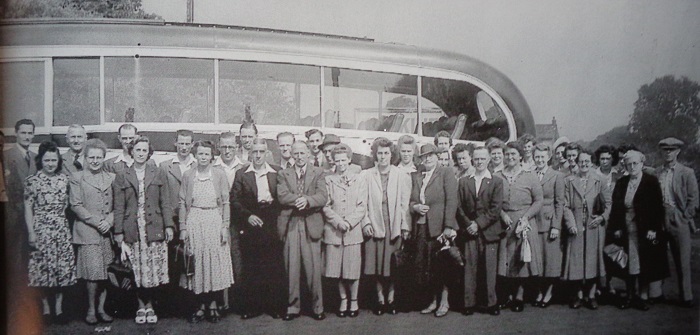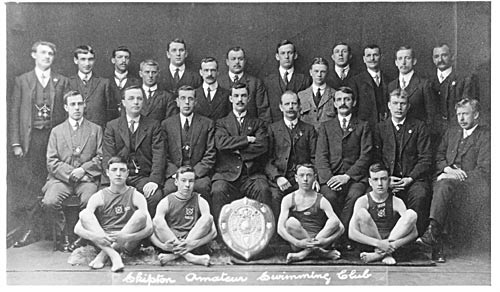
From the Hodgson Collection at Skipton Local Studies Library

Airedale & Wharfedale Family History Society
Finding New Routes to Trace Your Old Roots

From the Hodgson Collection at Skipton Local Studies Library

Have you ever wondered what happened to medals awarded to members of your family for serving in the Armed Forces during World War 2? They could have been sold or now be in the possession of another relative. There is also the possibility they were never claimed.
Read Moreby Brian Clayton
George Fox (1624-1691) is credited with founding the Society of Friends c.1651/2. Born July 1624 at Fenny Drayton, Leicestershire, the son of Christopher FOX & Mary, née LAGO, he was brought up in a Christian family. His father, a weaver, held the office of churchwarden. George as a youth, was apprenticed as a shoemaker. At an early age he was moved towards a deeper concern about religion and, as a young man, he was involved with the separatists. Later, in Mansfield, he became leader of the Nottinghamshire “Children of Light” movement. After serving in prison in Derby 1650-1651 for his dissenting views, George went on a religious mission throughout the north. He preached in the Pendle area of Lancashire, throughout Wensleydale and the districts of Sedburgh and Dent. So rapidly did the views of this leader of men spread that within a short time he had gathered many Ministers (50-60) to go forth and spread his word. It is possible that one of these brought the faith to the Rawdon area but there is no record of a personal visit by George Fox to Rawdon.
Read More| Joseph | Hudson | house rent & turves | £9-2-6 |
| Ellen | Knowles | house rent & turves | £9-17-4 |
| Ann | Hebdin | house rent & turves | £6-12-4 |
| Hannah | Kay | house rent & coals | £7-6-6 |
| Margaret | Knowles | house rent | £6-19-0 |
| Henry | Green | Rent & trousers & clogs 18/4 | £4-18-4 |
| Dinah | Verity | house rent & coals | £7-16 |
| Nancy | Pickover | rent | £4-17-6 |
| Mary | Nailor | house rent & coals | £7-16-0 |
| Eliz | Bumby | house rent & coals | £7-16-0 |
These records run from 1724 to 1869 and are held at Northallerton Record Office
By Anne Read
Hon.Curator The Folly Museum
Zion Independent Chapel was built in 1816 and for the next two centuries played an important part in the life of Settle. Sadly, it closed in 2015 just a year short of its bi-centenary.
Zion was one of the three first places of worship to be built in Settle. There was no parish church in the town until 1838 as Settle was a part of the ancient parish of Giggleswick. The Quaker Meeting House was built in 1678 and the Wesleyan Chapel in 1796. It took its name like many other nonconformist chapels from the original hilltop fortress captured by King David which became the oldest part of the city of Jerusalem. Settle’s Zion Chapel is particularly well-named, standing as it does at one of the highest points in the town.
Nonconformity flourished in Craven thanks to the efforts of ‘The Itinerants’, a group based in the industrial West Riding who made it a part of their mission to strengthen the churches in rural areas. Their stirring preaching drew great crowds in Settle and it is reported that at one open-air gathering in 1813 an audience of ‘not less than a thousand’ was present. There was clearly a pressing need to build a chapel!
The response of the working people of Settle was astounding. Within a year or so, the sum of £200 had been raised. The Itinerary Society contributed a further £100, land was purchased from Mr John Birkbeck and the new chapel was erected in 1816. The congregation was entirely responsible for managing and funding its own affairs, including the payment of a Minister. The spirit of sharing skills and playing a lively part in the numerous social activities taking place in the town was characteristic of the Zion congregation well into this century.
There were many ups and downs in the early years of the Chapel with frequent changes of Minister and many periods when services were taken by students from Idle Academy who often had to make the journey to Settle on foot. One Minister from 1835 to 1838, the Revd. John Williams of Grassington reduced the congregation to a state of chaos and was asked to resign because he actively preached against the Temperance movement! Another, the Revd. William Jackson was, in 1852, asked to resign because of neglect of his duties
At this point a unique development took place – for a period of several months the Revd. Rowland Ingram, having just resigned as Vicar of Giggleswick, preached at Zion every Sunday evening, providing a first example of inter-denominational co-operation and community spirit which has been a hallmark of Zion ever since.
In those days, the Chapel interior was very bare and uncomfortable with upright deal pews, forms for the children and a big iron stove which either smoked, scalded everyone with hot steam or went out; the gallery was not used in winter, there was no floor-covering of any kind and the space was lit by groups of tallow candles which had to be trimmed during the service and frequently went out – much to the delight of the youngsters. There were two ‘singing pews’ but no instrument except a bass fiddle.
There was a change for the better after the appointment of the Revd. Samuel Compston in 1855; he was the first minister to really ‘settle’ in Settle and he set the pattern for all the dedicated Ministers who followed right up to the closure of the Chapel in 2015. Samuel revitalised the life of Zion: the long-standing chapel debt was extinguished, a choir formed, a harmonium (and later a pipe organ) bought and a number of mid-week activities begun. The interior of the Chapel was completely refitted in the early 1870s and a schoolroom built on at the back which also served as a hall with a stage for entertainments.
The pattern of services on Sundays was simply staggering by modern standards: morning Sunday School followed by morning service, followed by afternoon school, followed by afternoon service, followed by evening service! This pattern, with the later omission of the afternoon service continued well into the 20th century. Many people travelled a distance and services were also held in the Workhouse at Giggleswick, Tosside Chapel and local farms.
Social activities were numerous and there was something happening nearly every weekday evening – choir, orchestra, sewing circle, woodwork class, young people’s fellowship, men’s and ladies’ evenings, dramatic society; most of these regular activities contributed to the ongoing need to raise funds for all aspects of Zion’s work including missionary work. Entertainments, ‘socials’ and Garden Parties were a regular part of the calendar and involved the whole local community, taking place in venues across the district, including the Music Hall (later the Victoria Hall) and the gardens of the larger houses such as Ashfield, Cragdale and Whitefriars. On top of all this the groups arranged outings and even holidays to different parts of the country. The sheer amount of organisation that went on is quite breathtaking!
Sunday Schools were especially important for the part they played in broadening the overall education of the children; as well as studying scripture the children went on regular rambles in the hills above Settle and learned about the natural history and antiquities of the area.
Two of Zion’s most famous sons – the Revd. Benjamin Waugh who founded the NSPCC and Dr James Riley who as a medical researcher in Dundee did groundbreaking work on Mast Cells greatly advancing our understanding of how to treat and manage inflammatory and respiratory conditions – received their earliest education at Zion’s Sunday School.
The Revd. George Moffat was Zion’s longest-serving Minister and on his retirement in 1976 he was presented with a book of memories, which contain a whole range of anecdotes, some serious and others light-hearted. Here is just one of them: The 1934 Junior Christmas party: “We could not believe our ears! Father Christmas was coming along the narrow passage to the Sunday School door on a HORSE! Poor creature! It must have hated coming into that warm, brightly-lit room and being pushed through the doors … Then it happened. Horse manure all over the school room floor. Following was a distraught Mr Nelson with a bucket and shovel trying to catch the mess as it fell.



